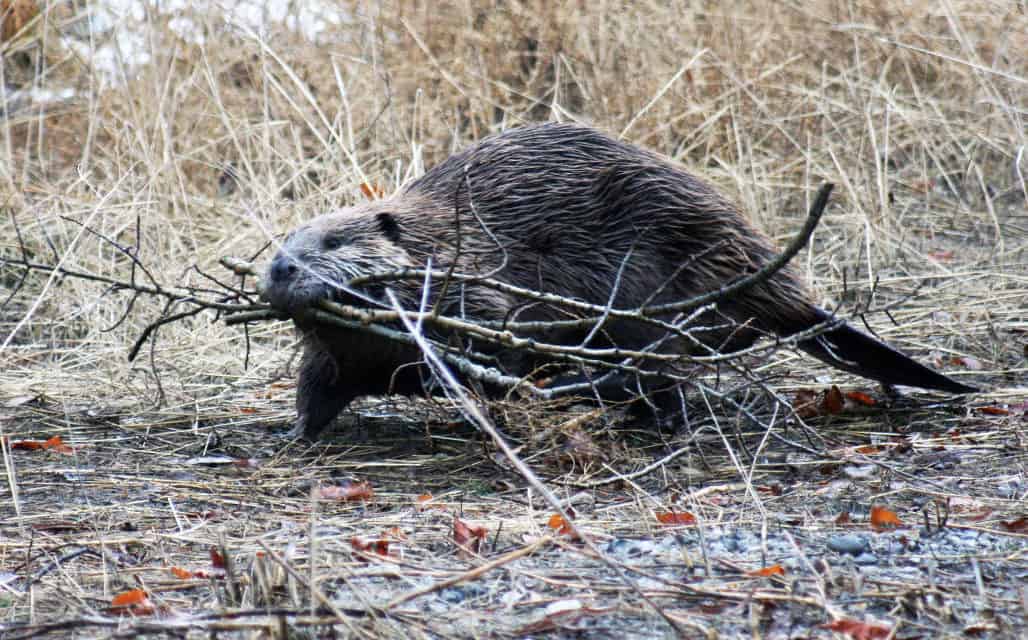By Melissa Wynn
There are few creatures as interesting to watch as the beaver. These perpetual builders are second only to humans in their ability to change the landscape to suit their needs. Much like ourselves, the busy beaver builds his home, called a lodge, of logs, stones and mud for mortar. An underwater entrance is a must, so a stream to dam up in a forested area is prime beaver real estate.
Sharp front teeth that never stop growing and strong jaws enable the beaver to gnaw down a tree three feet in diameter in just a few hours. An adult beaver will cut down about 200 trees a year. A mated pair can easily have the stream blocked with fallen trees and a pond forming in a single night, laying the foundation for the dam and filling their new home’s protective moat. They continue to build the dome shaped lodge with twigs and branches, filling in the cracks with mud and rocks carried in their fronts paws while lumbering along on hind legs and using their thick, flat, hairless tail for balance. Those amazing tails also aid in swimming and are used to make a loud SLAP on the water as an alarm when the beavers feel threatened. After sounding the alarm for the rest of the family, all retreat to the safety of the lodge interior . Simply designed, this safe haven is just two small rooms. The first is like a mud porch for shedding water and shaking off their oily waterproof coat before going into the drier main living room that is shared by all members of the colony.
Colonies are made of family units that include a male and female that are mated for life and their young. Baby beavers stay with Mom and Dad for two years and find a mate of their own after that. A mated pair will have a litter of one to four kits every spring and the yearlings act as babysitters and teachers to their little brothers and sisters.
All beavers must be taught to peel back the bark from the aspens, willows and cottonwood trees to get at the tender cambium between the rough bark and the hard wood that makes up a large portion of the herbivorous beaver diet. Water lily tubers, clover, apples and berries are a few other seasonal favorites of these largest of North American rodents. Not only do the crafty beavers build a warm and safe home for the winter, they also stash a rich cache of green branches in the cold waters of their pond beneath the lodge. This inventive refrigerator keeps the colony fat and happy through the winter.
Although colonies reuse the same lodges year after year it isn’t uncommon to find them abandoned during months of plenty. The colony will often build a temporary second lodge near a favorite summer feeding area. Beavers are territorial but won’t defend the summer camp as fiercely as they will the main winter residence. When the first frosts come, the family will wander home and take care of the necessary repairs to the lodge including a fresh coat of mud on the roof that dries hard as cement when it cures in the cold of the late autumn season. Predators like, wolves, mountain lion and wolverines are challenged to dig through this carefully installed armor.
Beavers definitely have the forest building business all wrapped up. Late evening and moonlit nights are the best time to watch to these fuzzy engineers in action. Next time you are hiking in the forest near the streams in our beautiful Sierra Nevada home,try to locate a beaver pond with a lodge and go back at night and wait. If you are very still and stay low and quiet, the gentle but skittish marvels of nature will waddle about their business . Never get too close or try to touch them. Gentle or not, beavers are still wild animals. Keep your distance and enjoy nature’s busy builder.
Facts courtesy of www.beaversww.org
nationalgeographic.com and discovery.com













